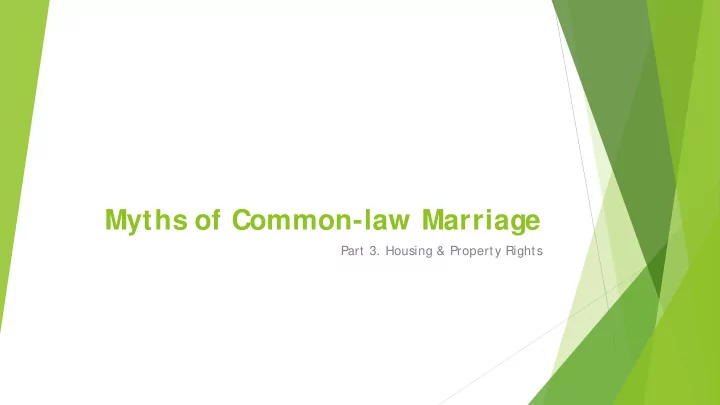

Myths of Common-law Marriage Part 3. Housing & Property Rights
The Myth “ Unmarried (common-law) couples t hat live t oget her for years share equal legal right s as married couples.” THIS IS FALSE Common-law couples are not protected under property law The length of time a couple is together is not a consideration under English law What can Cohabitants do to protect themselves?
The S tatistics In 2017 there were 19.0 million families in the UK, a 15% increase from 16.6 million in 1996. With 12.9 million families, the married or civil partner couple family remains the most common in 2017, with the cohabiting couple family growing the fastest. In the UK there were 27.2 million households in 2017, resulting in an average household size of 2.4. www.ons.gov.uk/ peoplepopulationandcommunity/ birthsdeathsandmarriages/ families/ bulletins/ familiesandhouseholds/ 2017
Protection for Cohabitants Be Proactive - it is possible for cohabitants to enter into a cohabitation agreement. This document may help courts to determine - in the event of a dispute - what the intentions were for dividing property. Be Aware - cohabitation agreements are not legally binding. They should not be relied upon as a contract. It should be accompanied by another legal document such as a will or declaration of trust. Be Legally Recognized - marriage is not the only formal relationship agreement to confer property benefits. Couples may become civil partners to gain legal protection.
Tenancy One married partner cannot ej ect the other from the matrimonial home without specific court instruction. A common-law partner may ej ect anyone who is not on the lease agreement. Married partners have the right to request the landlord remove a name, or transfer a tenancy agreement, only if both partners agree to do so. Married partners have the right to apply to court for tenancy agreement transfer in the event of a dispute. Common-law partners hold none of these rights as tenants.
Home-owners A common-law partner - as sole owner - has the right to stay in the home. They can request that their partner leaves the property, but they cannot be ej ected if they demonstrate they have a beneficial interest in the property. Common-law j oint owners have equal rights to remain in the home. The only thing that may affect this is if domestic violence is involved, or the courts find the best interest of any involved children is that a specific partner leaves. The common-law partner of a sole owner does not have rights to remain and may be evicted by the owner, if there is no beneficial interest identified.
Right to Remain for Married Couples Both married partners have equal rights to remain in the martial home, regardless of whose name is on the mortgage. Referred to as Home Rights , this is automatically granted at the time of marriage. Both sole and j oint owners of a martial home are unable to sell the property without the express agreement of both parties.
The Legislation The Family Law Act 1996 Provides cohabitants the right to apply for an occupation order to the family home under particular criteria. This allows courts to temporarily transfer property rights, and impose restrictions to interactions within the family home and surrounding area. The Children Act 1989 Provides the court with powers to transfer ownership based on the best interests of the child within a relationship, allowing the courts to put involved children as the priority within a relationship dispute.
Occupation Orders Victims of domestic violence qualify for additional legal protection. Any partner suffering from domestic violence may apply for an occupation order, in which the court can stipulate who has access to the family home and surrounding area. The qualifying criteria for an occupation order are; you own or rent the home and it is, was, or was intended to be shared with a 1. husband or wife, civil partner, cohabitant, family member, person you’ re engaged to or parent of your child you don’ t own or rent the home but you’ re married or in a civil partnership 2. with the owner and you’ re living in the home (known as ‘ matrimonial home rights’ ) your former husband, wife or civil partner is the owner or tenant, and the 3. home is, was, or was intended to be your shared matrimonial home the person you cohabit or cohabited with is the owner or tenant, and the 4. home is, was, or was intended to be your shared home www.gov.uk/ inj unct ion-domest ic-violence/ eligibility-occupat ion
S eek Legal Advice In matters of family and property dispute, always seek legal advice. Contact S helter, the Citizens Advice Bureau, or a Family law specialist. http:/ / england.shelter.org.uk/ https:/ / www.citizensadvice.org.uk/ https:/ / childlawadvice.org.uk/
Recommend
More recommend